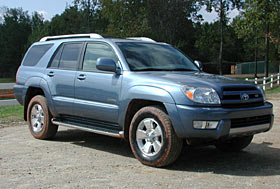|
|
|||||
|
The 2003 4Runner also sees the introduction the all-new 4.0L V6 aluminum engine with variable valve timing with intelligence (VVT-i). The V6 puts out 245hp at 5,200rpm and 282 lb-ft of torque at 3,800rpm. The new low-emission motor is Toyota's first aluminum truck engine in a light truck and uses an electronic throttle instead of the traditional, and oh so old-school, throttle cable tied to the accelerator pedal. The 4WD 4Runners weigh in at 5,380 pounds and the V6 is estimated to get 17/20 mpg. The engine is mated to a 4-speed ECT-i automatic transmission. Toyota no longer offers a manual tranny in the 4Runner. If your goal is speedy throttle response and zipping around town, then believe it or not, the less-expensive, lighter-weight V6 should be your engine of choice. If you plan on towing 5,000 pounds then the 4.7L V8 is the way to go. The familiar iron block and aluminum head i-Force V8 is the same motor currently offered in Sequoias, Tundras, and Land Cruisers. V8 models weigh in at 130 pounds more than their V6 counterparts and get an estimated 15/19 mpg in the 4WD models. The i-Force puts out 235hp at 4,800 rpm and 320 lb-ft of torque at 3,400 rpm. Though the V8 puts out less horsepower than the V6, where the V8 really shines, is its incredibly flat torque curve. Click here to view curve comparisons.
Mated to the V8 is Toyota's first use of an ECT-i five-speed automatic with overdrive in a light truck. This tranny is equipped with an artificial intelligence shift control, which changes gear-shifting patterns according to the driver's input and driving conditions. It also uses an aluminum front planetary gear, which reduces its weight by nearly 50%. All 4Runners feature an integrated tow hitch which is actually part of the frame. The towing capacity is rated at 5,000 but unofficially, the V8 should be able to pull more than that. A draw bar and a high-capacity seven-pin electrical connector are also included standard. Moving back to the transfer case, both V6 and V8 models use a two-speed transfer case. V6 models include a Torsen® limited slip center differential with locking capability to provide a full-time 4WD system with the ability to select 2WD. The new torque-sensing feature allows the torque split mid-point to be biased toward the rear in most driving conditions with a static 40/60 front-to-rear-split. When the front wheels lose traction, the Torsen can send up to 71% of the power to the rear and when rear wheels slip, up to 53% can go to the front. All 4WD 4Runners equipped with the V8 are full-time 4WD and also come with the Torsen limited slip. If the Torsen isn't enough to keep you moving forward, the 4Runner also includes Electronic Brake Force Distribution (EBD) which can apply varying amounts of brake force to any of the 4Runner's four disk brakes. For even more control on wet roads, Variable Skid Control (VSC) is also added to the braking system. More on this later. New to the 4Runner this year is also Hill-Start Assist Control (HAC) which will hold the truck in place while pointed uphill on slopes. Instead of taking your foot off the brake and having to race to the accelerator (or two-foot like us), HAC lets you move your foot without rolling backward. Nice touch. Adding to the alphabet soup on the 4WD models is Downhill Assist Control (DAC). DAC is similar to Land Rover's Hill Descent Control. When the 4Runner is in low range, keeping your foot off the brake allows the system to keep the truck at a 2-4mph pace when going down hills. What was interesting during our off-road test drive was feeling the system work as a single wheel dropped off into a rut while the other three stayed level. You could feel the system working to slow that dropping wheel to keep pace with the other three. In other words, there's a lot more going on here than just engine breaking. The 4Runner is being offered in three trim levels; SR5 (base), Sport Edition, and Limited. The new look of the truck visually ties it in with the rest of the Toyota SUV line. At a glance you are now likely to notice styling cues from the Highlander and Sequoia. Personal taste will dictate whether you like the 4Runner's new body cladding. Much more plastic exists on this new version, with huge fender flares, big plastic bumpers, and lots of lower cladding. The Limited models get color-keyed cladding while the Sports and SR5s get dark gray. Our preference is actually the gray.
The Sport models are instantly recognizable not only by the cladding, but by their hood scoops. We have yet to confirm whether the scoop is at all functional since it does not exist on the Limited model, even with the V8. All 4WD models allow 9.1 inches of minimum ground clearance, while 2WD models are slightly less at 8.9 inches. If you're keeping track, the Jeep Liberty has a minimum of 6.4 inches and the Jeep Wrangler, has a minimum clearance of 8.2 inches. Both Jeeps do beat the 4Runner in approach and departure angles, where the 4Runner comes in at 32 degrees and 24 degrees respectively. As for rolling stock, the SR5s come standard with P265/70R16s (30.6" x 10.43") on steel wheels, while the Sports and Limiteds run on P265/65R17s (30.56" x 10.43") and alloy wheels. |
|||||




